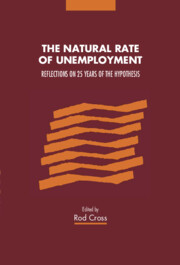Book contents
- Frontmatter
- Contents
- List of Contributors
- Preface
- 1 Introduction
- Part I The theoretical framework
- 2 The origins and further development of the natural rate of unemployment
- 3 The natural rate as new classical macroeconomics
- 4 Theoretical reflections on the ‘natural rate of unemployment‘
- 5 Of coconuts, decomposition, and a jackass: the genealogy of the natural rate
- Part II Adjustment, ranges of equilibria and hysteresis
- Part III Empirical tests and macro models
- Part IV Political economy
- Index
3 - The natural rate as new classical macroeconomics
Published online by Cambridge University Press: 03 May 2011
- Frontmatter
- Contents
- List of Contributors
- Preface
- 1 Introduction
- Part I The theoretical framework
- 2 The origins and further development of the natural rate of unemployment
- 3 The natural rate as new classical macroeconomics
- 4 Theoretical reflections on the ‘natural rate of unemployment‘
- 5 Of coconuts, decomposition, and a jackass: the genealogy of the natural rate
- Part II Adjustment, ranges of equilibria and hysteresis
- Part III Empirical tests and macro models
- Part IV Political economy
- Index
Summary
Friedman, Lucas, and market clearing
In retrospect, Friedman's 1967 Presidential Address to the American Economic Association (Friedman, 1968) was the opening shot of the new classical macroeconomics, the precursor of Lucas's ‘misperceptions’ explanation of Phillips curve observations and of the ‘policy ineffectiveness proposition’. Like Lucas (1973) and other new classicals, Friedman deploys ancient classical money-is-a-veil doctrine to argue that only real prices and real wages can determine real quantities of production and employment. Apparent relations between money prices and real quantities, like the Phillips curve, are bound to be ephemeral, especially if policymakers try to exploit them. The Friedman–Lucas doctrine is that the economy behaves as if markets were determining real prices all the time. Those prices are the arguments in supply and demand functions, and equalities of demand and supply shape the path of the economy.
The natural rate, according to Friedman, is ‘the level that would be ground out by the Walrasian system of general equilibrium equations’ (1968, p. 8). The sentence continues with the proviso that ‘imbedded’ in these equations are ‘market imperfections, stochastic variability in demands and supplies, the cost of gathering information about job vacancies and labour availabilities, the cost of mobility, and so on, phenomena that no one knows how to imbed in them’. After this gesture Friedman forgets about these awkward non-Walrasian phenomena and applies classical doctrine unconditionally.
How do deviations from the natural rate occur? There are two possible answers, not necessarily exclusive, new classical and Keynesian.
- Type
- Chapter
- Information
- The Natural Rate of UnemploymentReflections on 25 Years of the Hypothesis, pp. 32 - 42Publisher: Cambridge University PressPrint publication year: 1995
- 18
- Cited by



